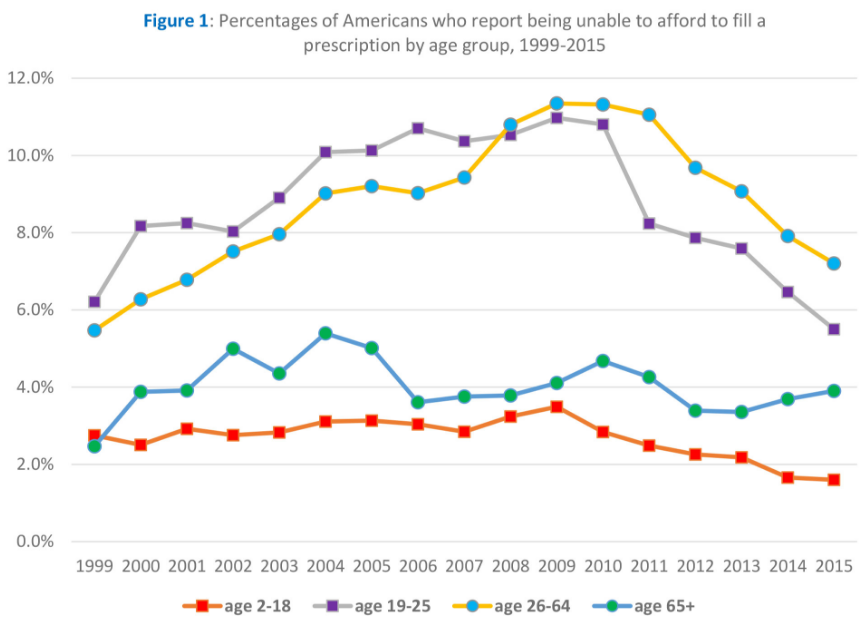Prescription Drug Medical Costs Less Problematic due to ACA
A new study uncovered that more Americans are able to afford the medical costs associated with their prescription medication due to the Affordable Care Act.

- Recently, criticism popped up against the pharmaceutical company Mylan from the Hillary Clinton presidential campaign for its significant price increase for the life-saving EpiPen product. The EpiPen is vital in an emergency when a person who suffers from allergies is in need of a fair dose of epinephrine immediately. When the company Mylan bought the right to produce and sell the EpiPen in 2007, the medical costs for this product rose quickly.

“It’s wrong when drug companies put profits ahead of patients, raising prices without justifying the value behind them,” Former Secretary of State Hillary Clinton said in a public statement.
Sen. Amy Klobuchar (D-Minn.) called for an investigation into the pricing strategies and rising medical costs at Mylan while Sens. Susan Collins (R-Maine) and Claire McCaskill (D-Mo.) sent a letter to the CEO of this company requesting more data and details regarding the costs of the EpiPen.
“[The FTC and FDA] have plainly done less than they should be doing,” Sen. Richard Blumenthal (D., Conn.) told The Wall Street Journal. “There should be an immediate and urgent investigation that uncovers all of the facts in this price-gouging, and exposes the simple truth that there is no justification.”
It seems that, when a monopoly on a particular medication is present in the market, pharmaceutical companies are more likely to raise prices. Medical costs across pharmaceuticals are still problematic for many American families.
However, new research shows that more Americans have been able to afford the medical costs of prescription drugs since the passage of the 2010 Patient Protection and Affordable Care Act as well as the 2003 Medicare Modernization Act. The research comes from Washington State University and shows a continuous drop in the number of people unable to afford the costs of prescription drugs in recent years, according to a press release from the university.
At this point in time, there are still 20 million Americans reporting that they have difficulty with paying for their prescription medication. However, the researchers discovered that in 2009, as many as 25.1 million American citizens went without filling a prescription over the prior 12 months due to high medical costs they were unable to afford. Since the recession of 2009, this number has dropped significantly.
The researchers looked at all age groups but took seniors out of the equation and found that almost every group reported having serious difficulty with paying for their prescriptions during the years between 1999 and 2009.
Among seniors, problems surrounding medical costs for prescription drugs hit 5.4 percent in 2004 but dropped to only 3.6 percent by 2006 due to implementing the Medicare Part D program.
“To examine national changes in rates of cost-related prescription nonadherence (CRN) by age group, we used data from the 1999–2015 Sample Adult and Sample Child National Health Interview Surveys (n = 768 781). In a logistic regression analysis of 2015 data, we identified subgroups at risk for cost-related nonadherence,” the researchers wrote in the paper’s abstract.
“The proportion of all Americans who did not fill a prescription in the previous 12 months because they could not afford it grew from 1999 to 2009, peaking at 8.3% at the height of the Great Recession and dropping to 5.2% by 2015. CRN among seniors, however, peaked in 2004 at 5.4% and dropped to 3.6% after implementation of Medicare Part D in 2006. CRN is responsive to improved access related to implementation of Medicare Part D and the Affordable Care Act.”
The number of young adults between 19 to 25 years of age who claimed to be unable to fill a prescription dropped quickly from 10.8 percent in 2010 to 8.2 percent in 2011. A major reason for this may be due to the fact that young adults up to age 26 could remain on their parents’ health insurance plans because of a provision within the Affordable Care Act.
Other important initiatives under the Affordable Care Act have been to expand Medicaid programs and provide more coverage options under public health insurance exchanges not dependent upon employer-based insurance. This also led to a drop in the number of working adults from 26 to 64 years old finding medical costs for prescription drugs too high. The study, which was published in the American Journal of Public Health, shows that the rate dropped from 9.1 percent in 2013 to 7.9 percent in 2014.
“The takeaway is that health policy matters,” Jae Kennedy, Professor and Chair of the Department of Health Policy and Administration at WSU’s College of Nursing and study author, said in the press release. “In both Republican and Democratic administrations, program changes in health care financing were associated with improved prescription affordability.”
The researchers also noted that more improvements could be achieved if additional states begin to participate in Medicaid expansion protocols under the Affordable Care Act. Despite the fact that pharmaceutical companies like Mylan may raise their prices for prescription drugs, it is important to note the fact that fewer Americans are having trouble with certain medical costs due to the Affordable Care Act.
Image Credit: Washington State University
Dig Deeper:

